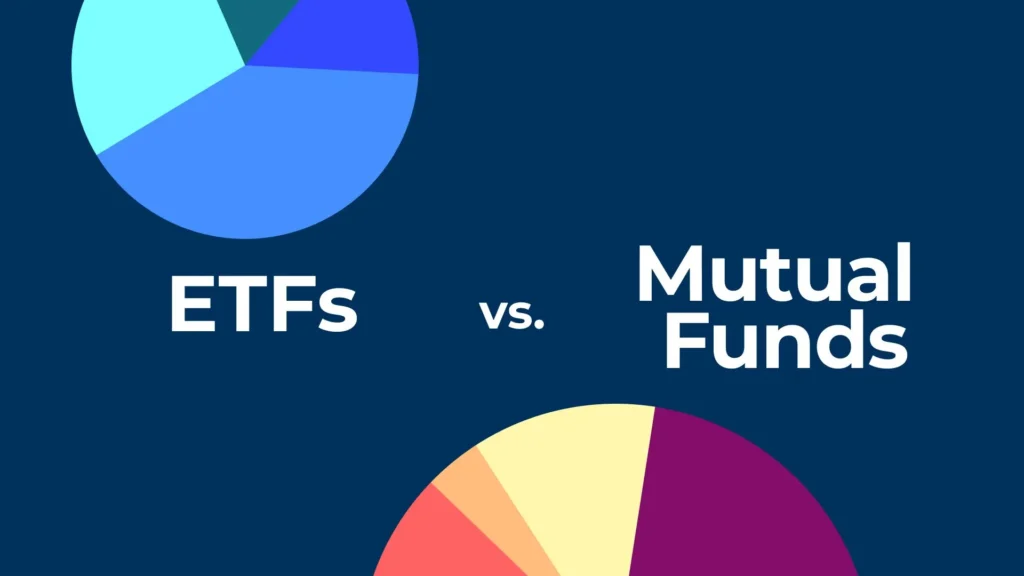Whether you’re opening your first brokerage account or exploring investment options for retirement, you’ve likely encountered the debate between Exchange-Traded Funds (ETFs) and Mutual Funds. Both provide access to diversified portfolios and play an important role in long-term financial planning. However, the choice between them can feel overwhelming—especially for beginners.
This comprehensive guide explores the features, benefits, drawbacks, and ideal use cases for each, so you can decide which option aligns best with your financial goals.
🧠 Understanding the Basics
Before diving into comparisons, it’s important to understand what each investment vehicle is:
🔹 What Is an ETF?
An Exchange-Traded Fund (ETF) is a type of investment fund that holds a basket of assets like stocks, bonds, or commodities. ETFs trade on major stock exchanges just like individual stocks, allowing investors to buy and sell throughout the trading day.
Key Characteristics of ETFs:
- Real-time pricing and intraday trading
- Typically low expense ratios
- Often passive (tracking an index)
- Highly transparent holdings
- No minimum investment requirements
🔹 What Is a Mutual Fund?
A Mutual Fund pools money from multiple investors to buy a diversified set of securities. Unlike ETFs, mutual funds are priced once per day after the market closes. You buy or redeem shares directly from the fund company at net asset value (NAV).
Key Characteristics of Mutual Funds:
- Managed by professional fund managers
- Active or passive strategies
- Higher fees compared to ETFs
- May have minimum investment requirements
- Automatic reinvestment options
🧮 Comparing Costs
Cost is one of the most important factors for new investors to consider. Fees can quietly eat away at your returns over time, so understanding them upfront is crucial.
| Cost Type | ETFs | Mutual Funds |
|---|---|---|
| Expense Ratio | Usually between 0.03%–0.50% | Can range from 0.50%–2.00% |
| Transaction Fees | Brokerage commissions (some free) | Usually none, unless selling early |
| Sales Load | None | May include front-end or back-end |
| Minimum Investment | Often $0 or the cost of one share | $500–$3,000+, depending on the fund |
💸 Pro Tip: Look for no-load mutual funds and commission-free ETFs to minimize entry costs. Some platforms, like Fidelity or Schwab, offer beginner-friendly options with no minimums.
💼 Investment Strategies
Your preferred investment strategy also determines which type of fund might be better suited for you.
✅ ETFs: Ideal for DIY Investors
ETFs are great for those who want control. You can:
- Buy and sell anytime during market hours
- Strategically manage holdings based on trends
- Use stop-loss or limit orders to control trading
- Easily adjust your portfolio allocation
Some investors use ETFs to build their own versions of a mutual fund portfolio—with exposure to different sectors, geographies, or asset classes.
✅ Mutual Funds: Best for Passive Investors
Mutual funds simplify the investing process. Once you’ve chosen a fund:
- Professional managers handle asset selection
- Dividends are reinvested automatically
- Portfolios are rebalanced regularly
- Ideal for long-term “set it and forget it” strategies
Many retirement accounts (401(k)s, IRAs) heavily feature mutual funds for their simplicity and reliability.
📈 Performance and Risk Considerations
While historical returns vary, ETFs tend to perform in line with their benchmark indices due to their passive nature. Mutual funds may either outperform or underperform based on how actively they’re managed.
🔍 ETF Performance Traits
- Lower risk due to index tracking
- Transparency in holdings
- Less chance of surprise taxable events
🔍 Mutual Fund Performance Traits
- Potential for outperformance via active management
- Greater volatility depending on investment style
- Risk of underperformance if managers fail to beat benchmarks
📊 Important Note: Just because a fund is actively managed doesn’t mean it will outperform. Consider tracking error and long-term consistency over flashy short-term gains.
🤝 Tax Efficiency: A Hidden Advantage
Taxes often catch beginners off guard, but they’re an essential piece of the investing puzzle.
✅ ETF Tax Advantages:
- “In-kind” redemption process minimizes capital gains
- No automatic taxable distributions
- Excellent for taxable brokerage accounts
⚠️ Mutual Fund Tax Drawbacks:
- Fund managers must sell assets to rebalance, triggering capital gains
- Distributions may be taxed even if you don’t sell your shares
- Not ideal for high-tax brackets
📜 Tax Tip: If you’re investing through a retirement account, the tax implications are less important since accounts like IRAs and 401(k)s are tax-advantaged.
🔄 Liquidity and Access
🕒 ETFs:
- Can be traded anytime during market hours
- Immediate pricing makes buying/selling easier
- Suitable for tactical asset allocation
🌅 Mutual Funds:
- Priced once per day after markets close
- Trades processed at NAV—not real-time
- Better for long-term investment plans
🚦 Beginner Tip: If you’re planning to make frequent changes to your portfolio, ETFs are likely the better choice.
🧩 Choosing the Right Fund: A Beginner’s Checklist
Here’s a quick cheat sheet to help you decide:
| Criteria | Best Option |
|---|---|
| Low costs | ETFs |
| Professional management | Mutual Funds |
| Tax efficiency | ETFs |
| Simplicity | Mutual Funds |
| Real-time trading | ETFs |
| Retirement account investing | Mutual Funds |
🎯 Personalization Tip: Your choice should reflect your goals, risk tolerance, and investment horizon. Don’t be swayed solely by popularity or past performance.
📚 Real-Life Examples
Let’s look at two investors to see how the decision might play out:
👩 Fatima: The First-Time Investor
Fatima is 28, just opened her first brokerage account, and wants to start small. She chooses a low-cost ETF tracking the S&P 500, allowing her to invest $100 and gradually build her portfolio.
Why it works:
- No minimums
- Simple diversification
- Easy to manage from her mobile app
👨 Ali: The Retirement Planner
Ali is 45, contributing to his company’s 401(k) plan. He opts for a target-date mutual fund that automatically adjusts asset allocation as retirement approaches.
Why it works:
- No active management required
- Auto-rebalancing
- Professional oversight
🌱 Tips for New Investors
Before you start investing, keep these principles in mind:
- 📌 Start Small: ETFs are great for learning the ropes with minimal risk.
- 📌 Diversify: Choose funds that span sectors and geographies.
- 📌 Stay Consistent: Regular contributions beat timing the market.
- 📌 Do Your Research: Review fund holdings, past performance, and fee structures.
- 📌 Avoid Emotional Investing: Don’t panic-sell during market drops.
📖 Many platforms offer free tools for beginners, like simulated portfolios or educational content. Use these resources to get comfortable before going all in.
📝 Final Verdict: Which Is Better?
For new investors, ETFs are often the better entry point due to their:
- Low fees
- No minimums
- Real-time trading
- Tax advantages
However, if you:
- Want a hands-off approach
- Prefer professional management
- Are investing through a retirement account
…Mutual Funds might be more suitable for your needs.
Ultimately, both can coexist in a diversified portfolio. Many seasoned investors use ETFs for taxable brokerage accounts and mutual funds within retirement accounts. The key is to match the product with your strategy.
I am Happy to help. Let’s make your investment content shine! 💡📈
🎁 Want a Surprise?
Click here to get redirected to a random post


